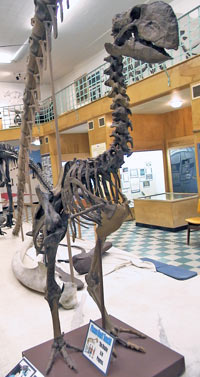Contact Us




Department of Geology and Geophysics
1000 E. University Ave., Dept. 3006
Laramie, WY 82071
Phone: 307-766-2646
Email: geolmus@uwyo.edu
Geological Museum
Department of Geology and Geophysics
Diatryma gigantea
'Giant Bird'Geologic Time: 55 million years ago (Early Eocene)
Geographic Range: Wyoming, New Mexico, Colorado, New Jersey, Canada's Ellesmere Island, France, Germany
Adult Size: Total Height - 7 ft. (2.14 m); Skull Length - 1.5 ft. (0.5 m); Weight - 385 lbs. (170 kg)
Habitat: Lowland Floodplains
Diet: Meat or possibly vegetation.
Diatryma was first discovered in Wyoming by Edward Drinker Cope in 1876. The Greek name Diatryma, which literally means "through a hole," was deduced for this bird because of its large foramina (perforations) that penetrate some of the foot bones. After the extinction of the dinosaurs, large ground-dwelling carnivorous birds, such as Diatryma, filled in the role left vacant by the flesh-eating theropod dinosaurs. The gigantic head, short powerful neck, and functionless forelimbs of Diatryma are all reminiscent of a small Tyrannosaurus rex, which suggests that it had a similar lifestyle and diet. Most paleontologists agree that Diatryma was a fierce carnivore preying on the contemporary mammals, especially young, sick and old individuals. Others however disagree and argue that it was a browsing herbivore, grazing on coarse vegetation and using its large bill as a scythe. The Willwood Formation in northeastern Wyoming is home to the most productive fossil assemblage of Diatryma remains in the world.

Contact Us




Department of Geology and Geophysics
1000 E. University Ave., Dept. 3006
Laramie, WY 82071
Phone: 307-766-2646
Email: geolmus@uwyo.edu
